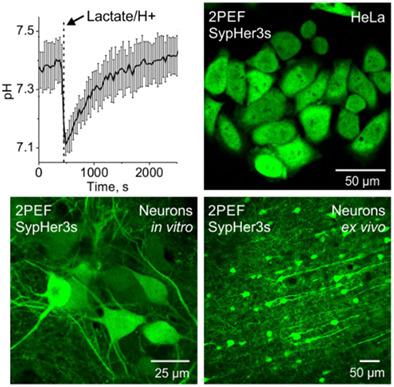当前位置:
X-MOL 学术
›
J. Biophotonics
›
论文详情
Our official English website, www.x-mol.net, welcomes your
feedback! (Note: you will need to create a separate account there.)
Enhanced‐contrast two‐photon optogenetic pH sensing and pH‐resolved brain imaging
Journal of Biophotonics ( IF 2.0 ) Pub Date : 2020-11-17 , DOI: 10.1002/jbio.202000301 Artem S Chebotarev 1 , Matvei S Pochechuev 1 , Aleksandr A Lanin 1, 2, 3 , Ilya V Kelmanson 4, 5 , Daria A Kotova 4 , Elena S Fetisova 4 , Anastasiya S Panova 4 , Dmitry S Bilan 4, 5 , Andrei B Fedotov 1, 2, 3, 6 , Vsevolod V Belousov 4, 5, 7 , Aleksei M Zheltikov 1, 2, 3, 8
Journal of Biophotonics ( IF 2.0 ) Pub Date : 2020-11-17 , DOI: 10.1002/jbio.202000301 Artem S Chebotarev 1 , Matvei S Pochechuev 1 , Aleksandr A Lanin 1, 2, 3 , Ilya V Kelmanson 4, 5 , Daria A Kotova 4 , Elena S Fetisova 4 , Anastasiya S Panova 4 , Dmitry S Bilan 4, 5 , Andrei B Fedotov 1, 2, 3, 6 , Vsevolod V Belousov 4, 5, 7 , Aleksei M Zheltikov 1, 2, 3, 8
Affiliation

|
We present experiments on cell cultures and brain slices that demonstrate two‐photon optogenetic pH sensing and pH‐resolved brain imaging using a laser driver whose spectrum is carefully tailored to provide the maximum contrast of a ratiometric two‐photon fluorescence readout from a high‐brightness genetically encoded yellow‐fluorescent‐protein‐based sensor, SypHer3s. Two spectrally isolated components of this laser field are set to induce two‐photon‐excited fluorescence (2PEF) by driving SypHer3s through one of two excitation pathways—via either the protonated or deprotonated states of its chromophore. With the spectrum of the laser field accurately adjusted for a maximum contrast of these two 2PEF signals, the ratio of their intensities is shown to provide a remarkably broad dynamic range for pH measurements, enabling high‐contrast optogenetic deep‐brain pH sensing and pH‐resolved 2PEF imaging within a vast class of biological systems, ranging from cell cultures to the living brain.
中文翻译:

增强对比度的双光子光遗传学pH传感和pH分辨脑成像
我们在细胞培养物和脑切片上进行的实验证明了使用激光驱动器的双光子光遗传学pH感测和pH分辨的脑成像,该激光驱动器的光谱经过精心定制,可从高亮度提供比例双光子荧光读数的最大对比度基因编码的基于黄色荧光蛋白的传感器SypHer3s。通过驱动SypHer3s通过发色团的质子化或去质子化状态,通过两个激发途径之一,驱动该SypHer3s,使该激光场的两个光谱分离的分量被设置为诱导两个光子激发的荧光(2PEF)。精确调整了激光场的光谱以针对这两个2PEF信号的最大对比度进行调整,显示了它们的强度比为pH测量提供了非常宽的动态范围,
更新日期:2020-11-17

中文翻译:

增强对比度的双光子光遗传学pH传感和pH分辨脑成像
我们在细胞培养物和脑切片上进行的实验证明了使用激光驱动器的双光子光遗传学pH感测和pH分辨的脑成像,该激光驱动器的光谱经过精心定制,可从高亮度提供比例双光子荧光读数的最大对比度基因编码的基于黄色荧光蛋白的传感器SypHer3s。通过驱动SypHer3s通过发色团的质子化或去质子化状态,通过两个激发途径之一,驱动该SypHer3s,使该激光场的两个光谱分离的分量被设置为诱导两个光子激发的荧光(2PEF)。精确调整了激光场的光谱以针对这两个2PEF信号的最大对比度进行调整,显示了它们的强度比为pH测量提供了非常宽的动态范围,












































 京公网安备 11010802027423号
京公网安备 11010802027423号